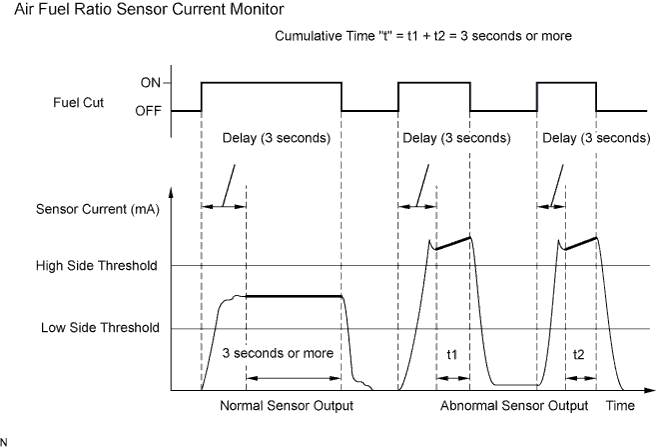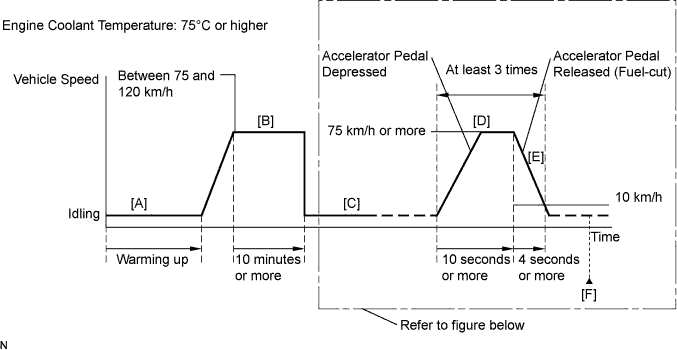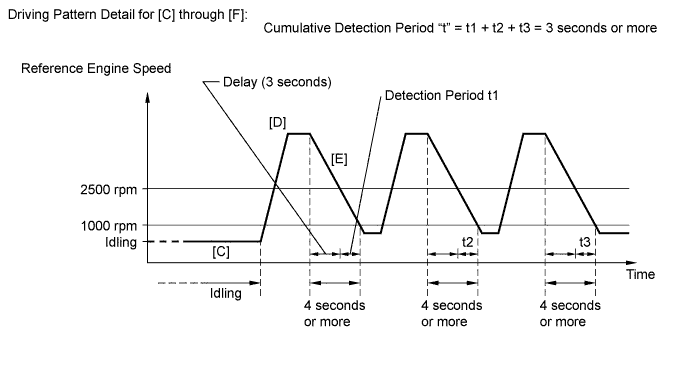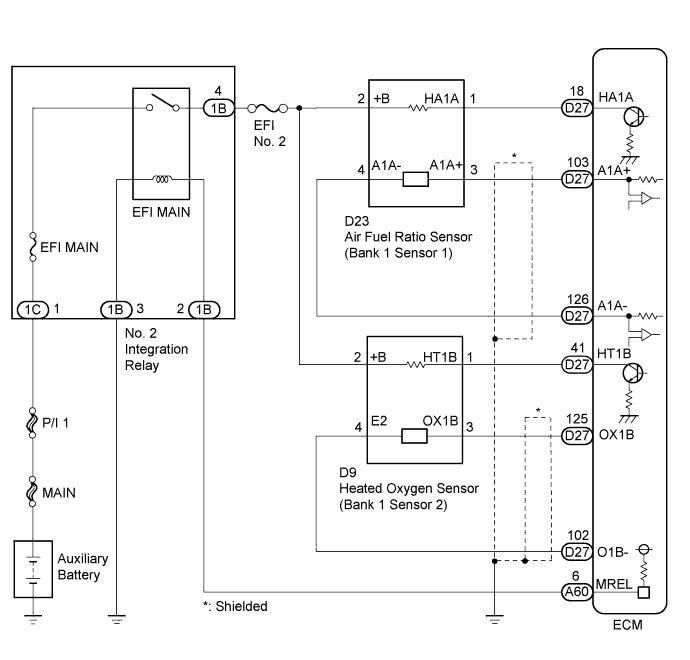DTC P2195 Oxygen (A/F) Sensor Signal Stuck Lean (Bank 1 Sensor 1)
DTC P2196 Oxygen (A/F) Sensor Signal Stuck Rich (Bank 1 Sensor 1)
Typical malfunction thresholds
Check any other dtcs output (in addition to p2195 or p2196)
Confirm if vehicle has run out of fuel in past
Perform confirmation driving pattern
Read value using intelligent tester (air fuel ratio sensor current)
Perform active test using intelligent tester (control the injection volume)
Inspect fuel injector assembly
Perform confirmation driving pattern
Perform active test using intelligent tester (control the egr step position)
Confirm whether malfunction has been successfully repaired
Perform confirmation driving pattern
Description
The air fuel ratio sensor generates voltage* that corresponds to the actual air fuel ratio. This sensor voltage is used to provide the ECM with feedback so that it can control the air fuel ratio. The ECM determines the deviation from the stoichiometric air fuel ratio level, and regulates the fuel injection duration. If the air fuel ratio sensor malfunctions, the ECM is unable to control the air fuel ratio accurately. The air fuel ratio sensor is a planar type with an integrated heater, which heats the solid electrolyte (zirconia element). This heater is controlled by the ECM. When the intake air volume is low (the exhaust gas temperature is low), current flows to the heater to heat the sensor, in order to facilitate accurate oxygen concentration detection. In addition, the sensor and heater portions are narrower than the conventional type. The heat generated by the heater is conducted to the solid electrolyte through the alumina, therefore the sensor activation is accelerated. A three-way catalytic converter is used in order to convert the carbon monoxide (CO), hydrocarbon (HC), and nitrogen oxide (NOx) into less harmful substances. To allow the three-way catalytic converter to function effectively, it is necessary to keep the air fuel ratio of the engine near the stoichiometric air fuel ratio. *: Value changes inside the ECM. Since the air fuel ratio sensor uses the current output element, the current is converted to a voltage inside the ECM. Any measurements taken at the air fuel ratio sensor or ECM connectors will show a constant voltage.

| DTC No. | DTC Detection Condition | Trouble Area |
| P2195 | Conditions (a) and (b) continue for 5 seconds or more (2 trip detection logic): (a) Air fuel ratio sensor voltage is higher than 3.8 V. (b) Heated oxygen sensor voltage is 0.21 V or higher. |
|
| While the fuel-cut operation is performed (during vehicle deceleration), the air fuel ratio sensor current is 2.2 mA or higher for 3 seconds (2 trip detection logic). |
|
|
| P2196 | Conditions (a) and (b) continue for 5 seconds or more (2 trip detection logic): (a) Air fuel ratio sensor voltage is below 2.8 V. (b) Heated oxygen sensor voltage is below 0.59 V. |
|
| While the fuel-cut operation is performed (during vehicle deceleration), the air fuel ratio sensor current is below 0.7 mA for 3 seconds (2 trip detection logic). |
|
HINT:
- When any of these DTCs are set, check the air fuel ratio sensor output voltage by entering the following menus: Powertrain / Engine and ECT / Data List / All Data / AFS Voltage B1S1.
- Short-term fuel trim values can also be read using the intelligent tester.
- The ECM regulates the voltages at the A1A+ and A1A- terminals of the ECM to a constant level. Therefore, the air fuel ratio sensor output voltage cannot be confirmed without using the intelligent tester.
- If an air fuel ratio sensor malfunction is detected, the ECM sets a DTC.
Monitor description
- Sensor voltage detection monitor Under air-fuel ratio feedback control, if the air fuel ratio sensor output voltage is below 2.8 V (very rich condition) for 5 seconds despite the heated oxygen sensor output voltage being below 0.59 V, the ECM stores DTC P2196. Alternatively, if the air fuel ratio sensor output voltage is higher than 3.8 V (very lean condition) for 5 seconds despite the heated oxygen sensor output voltage being 0.21 V or higher, DTC P2195 is stored.
- Sensor current detection monitor A rich air-fuel mixture causes a low air fuel ratio sensor current, and a lean air-fuel mixture causes a high air fuel ratio sensor current. Therefore, the sensor output becomes low during acceleration, and it becomes high during deceleration with the throttle valve fully closed. The ECM monitors the air fuel ratio sensor current during fuel-cut and detects any abnormal current values. If the air fuel ratio sensor output is 2.2 mA or higher for more than 3 seconds of cumulative time, the ECM interprets this as a malfunction in the air fuel ratio sensor and stores DTC P2195 (stuck on high side). If the air fuel ratio sensor output is below 0.7 mA for more than 3 seconds of cumulative time, the ECM stores DTC P2196 (stuck on low side).

Monitor strategy
| Required Sensors/Components (Main) | Air fuel ratio sensor |
| Required Sensors/Components (Related) | Heated oxygen sensor |
| Frequency of Operation | Continuous: Sensor voltage detection monitor Once per driving cycle: Sensor current detection monitor |
| Duration | 3 seconds: Sensor current detection monitor 5 seconds: Sensor voltage detection monitor |
Typical enabling conditions
| Time after engine start | 30 seconds or more |
| Air fuel ratio sensor status | Activated |
| Fuel system status | Closed-loop |
| Auxiliary battery voltage | 11 V or higher |
| Engine coolant temperature | 75°C (167°F) or higher |
| Atmospheric pressure | 76 kPa (570 mmHg) or higher |
| Air fuel ratio sensor status | Activated |
| Continuous time of fuel cut | 3 to 10 seconds |
Typical malfunction thresholds
| Rear heated oxygen sensor voltage | 0.21 V or higher |
| Air fuel ratio sensor voltage | Higher than 3.8 V |
| Rear heated oxygen sensor voltage | Below 0.59 V |
| Air fuel ratio sensor voltage | Below 2.8 V |
| Air fuel ratio sensor current | 2.2 mA or higher |
| Air fuel ratio sensor current | Below 0.7 mA |
Confirmation driving pattern
HINT:
This confirmation driving pattern is used in the "Perform Confirmation Driving Pattern" procedure of the following diagnostic troubleshooting procedure.


- Connect the intelligent tester to the DLC3.
- Turn the power switch on (IG).
- Turn the tester on.
- Clear the DTCs (even if no DTCs are stored, perform the clear DTC operation).
- Turn the power switch off and wait for 30 seconds.
- Turn the power switch on (IG) and turn the tester on.
- Put the engine in inspection mode (maintenance mode) .
- Start the engine, and warm it up until the engine coolant temperature reaches 75°C (167°F) or higher [A].
- On the tester, enter the following menus to check the fuel-cut status: Powertrain / Engine and ECT / Data List / All Data / Idle Fuel Cut.
- Drive the vehicle at between 75 and 120 km/h (47 and 75 mph) for at least 10 minutes [B].
CAUTION:
When performing the confirmation driving pattern, obey all speed limits and traffic laws.
- Move the shift lever in B [C].
- Accelerate the vehicle to 75 km/h (47 mph) or more by depressing the accelerator pedal for at least 10 seconds [D].
- Soon after performing step [D] above, release the accelerator pedal for at least 4 seconds without depressing the brake pedal in order to execute fuel-cut control [E].
HINT:
Fuel-cut control is executed when the accelerator pedal is released while the vehicle is moving at 35 km/h (22 mph) or slower (Fuel-cut control is prohibited when the engine sped decreases to 1000 rpm or lower).
- Allow the vehicle to decelerate until the vehicle speed decreases to less than 10 km/h (6 mph).
- Repeat steps [C] through [E] above at least 3 times in one driving cycle.
- Enter the following menus: Powertrain / Engine and ECT / DTC [F].
- Read the pending DTCs.
HINT:
- If a pending DTC is output, the system is malfunctioning.
- If a pending DTC is not output, perform the following procedure.
- Enter the following menus: Powertrain / Engine and ECT / Utility / All Readiness.
- Input the DTC: P2195 or P2196.
- Check the DTC judgment result.
Tester Display Description NORMAL - DTC judgment completed
- System normal
ABNORMAL - DTC judgment completed
- System abnormal
INCOMPLETE - DTC judgment not completed
- Perform driving pattern after confirming DTC enabling conditions
UNKNOWN - Unable to perform DTC judgment
- Number of DTCs which do not fulfill DTC preconditions has reached ECU memory limit
HINT:
- If the judgment result shows NORMAL, the system is normal.
- If the judgment result shows ABNORMAL, the system has a malfunction.
- If the judgment result shows INCOMPLETE or UNKNOWN, perform steps [B] through [E].
Wiring diagram

Inspection procedure
HINT:
- Although the DTC titles say oxygen sensor, these DTCs relate to the air fuel ratio sensor.
- Sensor 1 refers to the sensor mounted in front of the three-way catalytic converter and located near the engine assembly.
- Read freeze frame data using the intelligent tester. The ECM records vehicle and driving condition information as freeze frame data the moment a DTC is stored. When troubleshooting, freeze frame data can help determine if the vehicle was moving or stationary, if the engine was warmed up or not, if the air fuel ratio was lean or rich, and other data from the time the malfunction occurred.
- A low air fuel ratio sensor voltage could be caused by a rich air fuel mixture. Check for conditions that would cause the engine to run rich.
- A high air fuel ratio sensor voltage could be caused by a lean air fuel mixture. Check for conditions that would cause the engine to run lean.
- Sensor 1 refers to the sensor closest to the engine assembly.
- Sensor 2 refers to the sensor farthest away from the engine assembly.
| 1.CHECK ANY OTHER DTCS OUTPUT (IN ADDITION TO P2195 OR P2196) |
-
Connect the intelligent tester to the DLC3.
-
Turn the power switch on (IG).
-
Turn the tester on.
-
Enter the following menus: Powertrain / Engine and ECT / DTC.
-
Read the DTCs.
Result Result Proceed to DTC P2195 or P2196 is output A "P2195 or P2196" and "P0136, P0137 or P0138" are output A DTC P2195 or P2196 and other DTCs are output B
HINT:
If any DTCs relating to the air fuel ratio sensor (DTCs for the air fuel ratio sensor heater or air fuel ratio sensor admittance) are output, troubleshoot those DTCs first.
|
|
||||
| OK | |
| 2.CONFIRM IF VEHICLE HAS RUN OUT OF FUEL IN PAST |
-
Has the vehicle run out of fuel in the past?
|
|
||||
| YES | |
| 3.PERFORM CONFIRMATION DRIVING PATTERN |
-
Connect the intelligent tester to the DLC3.
-
Turn the power switch on (IG).
-
Turn the tester on.
-
Clear the DTCs .
-
Turn the power switch off and wait for 30 seconds.
-
Turn the power switch on (IG) and turn the tester on.
-
Put the engine in inspection mode (maintenance mode) .
-
Start the engine and warm it up.
-
Drive the vehicle in accordance with the driving pattern described in the Confirmation Driving Pattern.
-
Enter the following menus: Powertrain / Engine and ECT / Utility / All Readiness.
-
Input the DTC: P2195 or P2196.
-
Check the DTC judgment result.
Result Result Proceed to NORMAL (DTC is not output) A ABNORMAL (DTC P2195 or P2196 is output) B
|
|
||||
| A | |
|
| 4.READ VALUE USING INTELLIGENT TESTER (AIR FUEL RATIO SENSOR CURRENT) |
-
Connect the intelligent tester to the DLC3.
-
Turn the power switch on (IG).
-
Turn the tester on.
-
Clear the DTCs .
-
Put the engine in inspection mode (maintenance mode) .
-
Enter the following menus: Powertrain / Engine and ECT / Data List / All Data / AFS Current B1S1.
-
Check the value of the air fuel ratio sensor output current during fuel-cut, referring to the Drive Pattern Detail for [C] through [F] in the Confirmation Driving Pattern.
HINT:
- To measure the air fuel ratio sensor current precisely, perform the fuel-cut operation as long as possible.
- If it is difficult to measure the air fuel ratio sensor current, use the snapshot function of the tester.
Result Test Value Proceed to Within normal range (0.7 mA or higher, and below 2.2 mA) A Outside normal range (below 0.7 mA, or 2.2 mA or higher) B
|
|
||||
| OK | |
| 5.PERFORM ACTIVE TEST USING INTELLIGENT TESTER (CONTROL THE INJECTION VOLUME) |
-
Connect the intelligent tester to the DLC3.
-
Turn the power switch on (IG).
-
Turn the tester on.
-
Put the engine in inspection mode (maintenance mode) .
-
Start the engine.
-
Warm up the air fuel ratio sensor at an engine speed of 2500 rpm for 90 seconds.
-
Enter the following menus: Powertrain / Engine and ECT / Active Test / Control the Injection Volume.
-
Perform the Control the Injection Volume operation with the engine idling.
-
Monitor the output voltages of the air fuel ratio and heated oxygen sensors (AFS Voltage B1S1 and O2S B1S2) displayed on the tester.
HINT:
- Change the fuel injection volume within the range of -12.0% to +12.0%. The injection volume can be changed in fine gradations.
- The air fuel ratio sensor has an output delay of a few seconds and the heated oxygen sensor has a maximum output delay of approximately 20 seconds.
- If the sensor output voltage does not change (almost no reaction) while performing the Active Test, the sensor may be malfunctioning.
Standard Tester Display (Sensor) Injection Volume Status Voltage AFS Voltage B1S1 (Air fuel ratio) +12.0% Rich Below 3.1 V AFS Voltage B1S1 (Air fuel ratio) -12.0% Lean Higher than 3.4 V O2S B1S2 (Heated oxygen) +12.0% Rich Higher than 0.55 V O2S B1S2 (Heated oxygen) -12.0% Lean Below 0.4 V
Lean: During the Control the Injection Volume Active Test, the air fuel ratio sensor output voltage (AFS Voltage) is consistently higher than 3.4 V, and the heated oxygen sensor output voltage (O2S) is consistently below 0.4 V. Rich: During the Control the Injection Volume Active Test, the AFS Voltage is consistently below 3.1 V, and the O2S is consistently higher than 0.55 V. Lean/Rich: During the Control the Injection Volume Active Test, the output voltage of the heated oxygen sensor alternates correctly.Result Status of AFS Voltage B1S1 Status of O2S B1S2 Air Fuel Ratio Condition and Air Fuel Ratio Sensor Condition Proceed to Lean Lean Actual air fuel ratio lean A Rich Rich Actual air fuel ratio rich A Lean Lean/Rich Air fuel ratio sensor malfunction B Rich Lean/Rich Air fuel ratio sensor malfunction B Lean/Rich Lean/Rich Normal C
HINT:
Refer to "Data List / Active Test" [AFS Voltage B1S1 and O2S B1S2] .
|
|
||||
|
|
||||
| OK | |
| 6.CHECK INTAKE SYSTEM |
-
Check the intake system for vacuum leaks .
OK:
No leaks in intake system.
|
|
||||
| OK | |
| 7.CHECK FOR EXHAUST GAS LEAK |
-
Check for exhaust gas leaks from exhaust manifold sub-assembly and exhaust pipes..
OK:
No gas leaks.
|
|
||||
| OK | |
| 8.CHECK FUEL PRESSURE |
-
Check the fuel pressure .
|
|
||||
| OK | |
| 9.INSPECT FUEL INJECTOR ASSEMBLY |
-
Check the fuel injector assembly (whether fuel volume is high or low, and whether injector pattern is poor) .
|
|
||||
| OK | |
| 10.REPLACE AIR FUEL RATIO SENSOR |
-
Replace the air fuel ratio sensor .
| NEXT | |
| 11.PERFORM CONFIRMATION DRIVING PATTERN |
-
Connect the intelligent tester to the DLC3.
-
Turn the power switch on (IG).
-
Turn the tester on.
-
Clear the DTCs .
-
Turn the power switch off and wait for 30 seconds.
-
Drive the vehicle in accordance with the driving pattern described in the Confirmation Driving Pattern.
-
Enter the following menus: Powertrain / Engine and ECT / Utility / All Readiness.
-
Input the DTC: P2195 or P2196.
-
Check the DTC judgment result.
Result Result Proceed to ABNORMAL (DTC P2195 or P2196 is output) A NORMAL (DTC is not output) B
|
|
||||
| OK | |
| 12.PERFORM ACTIVE TEST USING INTELLIGENT TESTER (CONTROL THE EGR STEP POSITION) |
-
Connect the intelligent tester to the DLC3.
-
Turn the power switch on (IG).
-
Turn the tester on.
-
Put the engine in inspection mode (maintenance mode) .
-
Start the engine and warm it up until the engine coolant temperature reaches 75°C (167°F) or higher.
HINT:
The A/C switch and all accessory switches should be off.
-
Enter the following menus: Powertrain / Engine and ECT / Active Test / Control the EGR Step Position / Data List / All Data / Throttle Idle Position and MAP.
-
Confirm that the Throttle Idle Position is ON and check the engine idling condition and MAP values in the Data List while performing the Active Test.
HINT:
- Do not leave the EGR valve open for 10 seconds or more during the Active Test.
- Be sure to return the EGR valve to step 0 when the Active Test is completed.
- Do not open the EGR valve 30 steps or more during the Active Test.
OK:
MAP and idling condition change in response to EGR step position when Throttle Idle Position is ON in Data List.
Standard:
- EGR Step Position (Active Test) 0 Steps 0 to 30 Steps Idling condition Steady idling Idling changes from steady to rough idling or stalls MAP (Data List) MAP value is 20 to 40 kPa (150 to 300 mmHg) (EGR valve is fully closed) MAP value is at least +10 kPa (75 mmHg) higher than when EGR valve is fully closed HINT:
During Active Test, if the idling condition does not change in response to EGR step position, then there is probably a malfunction in the EGR valve.
Result Result Proceed to Outside of standard range A Within standard range B
|
|
||||
| OK | |
| 13.INSPECT EGR VALVE ASSEMBLY |
-
Remove the EGR valve assembly .
-
Check if the EGR valve is stuck open.
OK:
EGR valve us tightly closed.
|
|
||||
| OK | |
| 14.REPLACE ECM |
-
Replace the ECM .
| NEXT | |
| 15.CONFIRM WHETHER MALFUNCTION HAS BEEN SUCCESSFULLY REPAIRED |
-
Connect the intelligent tester to the DLC3.
-
Turn the power switch on (IG).
-
Turn the tester on.
-
Clear the DTCs .
-
Turn the power switch off and wait for 30 seconds.
-
Drive the vehicle in accordance with the driving pattern described in the Confirmation Driving Pattern.
-
Enter the following menus: Powertrain / Engine and ECT / Utility / All Readiness.
-
Input the DTC: P2195 or P2196.
-
Check the DTC judgment result.
Result Tester Display Description NORMAL - DTC judgment completed
- System normal
ABNORMAL - DTC judgment completed
- System abnormal
INCOMPLETE - DTC judgment not completed
- Perform driving pattern after confirming DTC enabling conditions
UNKNOWN - Unable to perform DTC judgment
- Number of DTCs which do not fulfill DTC preconditions has reached ECU memory limit
| NEXT | |
|
| 16.REPLACE AIR FUEL RATIO SENSOR |
-
Replace the air fuel ratio sensor .
| NEXT | |
| 17.PERFORM CONFIRMATION DRIVING PATTERN |
-
Connect the intelligent tester to the DLC3.
-
Turn the power switch on (IG).
-
Turn the tester on.
-
Clear the DTCs .
-
Turn the power switch off and wait for 30 seconds.
-
Drive the vehicle in accordance with the driving pattern described in the Confirmation Driving Pattern.
-
Enter the following menus: Powertrain / Engine and ECT / Utility / All Readiness.
-
Input the DTC: P2195 or P2196.
-
Check the DTC judgment result.
Result Result Proceed to NORMAL (DTC is not output) A ABNORMAL (DTC P2195 or P2196 is output) B
|
|
||||
| A | |
|
| 18.CHECK FUEL LINE |
-
Check the fuel lines for leaks or blockage.
|
|
||||
| OK | |
|